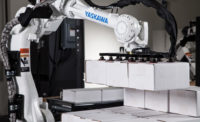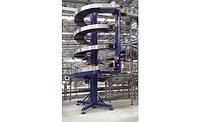Operations
Revamped equipment saves beverage manufacturers time, money
Pandemic contributes to demand for refurbished equipment

With the rise of sustainability initiatives in manufacturing, equipment refurbishment continues to see steady demand. However, it’s beyond sustainability that many beverage manufacturers are turning to refurbished equipment, with cost savings and time savings being among the top reasons.
Nandini Roy Choudhury, senior research manager of food and beverage and consumer goods at Fact.MR, Dublin, Ireland, notes that the pandemic led to a halt in manufacturing of heavy equipment and machinery, resulting in an order backlog and delay in timely deliveries that necessitated the need for refurbished equipment, especially in the food and beverage sector.
“Refurbished equipment has been helping the new [market] entrants with a low initial budget,” she says. “While there had been certain issues in building a link between the buyer and seller of refurbished equipment initially, with the advent of online auctioneers, it has been very easy these days to procure them.”

CLICK IMAGE TO WATCH VIDEO
Jeremy J. Sanders, president of United Food & Beverage (UFB), Hickory, N.C., says three key perks of opting for refurbished equipment are the savings of time, money and stress.
“Refurbished machinery can sometimes save companies up to 40% or 50% in budget,” he says. “Also, the turnaround and lead time is a fraction of new lead times.”
Rich Frain, CEO of Frain Group, Carol Stream, Ill., notes that most individual pieces of refurbished equipment must go out the door in two weeks or less, and they must work right away with minimal failures.
“Even brand-new equipment needs 50-150 hours to become Plug and Play,” he says. “People cannot buy used equipment and wait for the 250-plus hours of setup and refurbishing that the equipment needs in order to be Plug and Play.”
He adds that Frain’s Plug and Play portfolio consists of refurbished and brand-new equipment, and that in the past 18 months, the company has put together more than 37 completely integrated, Plug and Play packaging lines, which average eight to14 weeks to the Factory Acceptance Test.
“It is all about speed to market. Fifty percent of Frain’s Plug and Play equipment can be shipped within 48 hours,” he says. “With speed to market, the first product to shelf wins. The second most important factor after speed to market is a lack of significant budget. Ninety percent of the 37 lines we have integrated over the last 18 months have been variable expense or rentals.”
Fact.MR’s Choudhury notes that one of the foremost challenges in the refurbished equipment space occurs when the buyer wants to understand the quality of work performed by the equipment with its previous operator.
“Most prospective buyers of refurbished equipment in the beverages sector seek to see the equipment getting test-cycled before purchasing. Amid COVID-19, with several restrictions in place for factory visits, it became difficult for the user to make it possible for every buyer,” she says.
She notes that another challenge is that some of the refurbished equipment is not able to meet the “cent-percent” requirement of the buyer, meaning the buyer needs or might need to change some of the spare parts, which adds further cost to the procurement. However, workarounds are available for this issue.
“The [equipment] auctioneer suggests the best matches of equipment that meet the entire need of the user and suffices the objective of procurement. In this way, this can eliminate or reduce the cost of modification or change of spare parts that are to be borne by the buyer,” she says. “In addition, cost-level negotiations and limited period warranty provided by the existing users of refurbished equipment can address the utility skepticism of the buyers.”
Other trends affecting demand
Clair Frain, marketing specialist at Frain Group, notes that with everyone stuck at home the past year, unit price was of no object when it came to at-home food and beverage. As such, demand began to rise for certain beverage products, which impacted nearly every stakeholder up and down the supply chain.
“People were bored in their homes wanting new exciting drinks. We’ve built lines for companies trying to be the next best hard seltzer, capitalizing on a hot and trendy market,” she says. “We were able to do these lines in a third of the time of traditional packaging solutions such as [original equipment manufacturers] (OEMs).”
She notes that with companies needing to put 50% upfront ($500,000 to $1.5 million) just to get into the queue for new equipment, Frain Group was able to rent them a line for 10% of the traditional OEM startup cost.
UFB’s Sanders explains that much of the demand was for canned products such as ciders, beer, seltzers, energy drinks, malt liquors, along with variety packs featuring multiple flavors in a case. Given the high demand for equipment that handles these products, acquiring the equipment in a reasonable timeframe isn’t always possible.
“Consumers are driving the market demand for different ‘tastes’ in [a] case ― which is challenging for beverage manufacturers to produce in-house with space constraints and existing bottling lines,” Sanders says. “This means the demand for used canning machinery in the USA is well above the supply of machinery available to the market.”
Currently, there just isn’t enough refurbished equipment available to supply the needs of the manufacturing plants, Sanders notes.
“The demand for refurbished equipment continues to be strong due to very long lead times for new machinery, plus the cost savings [on refurbished equipment] versus new,” he says. “Manufacturers are demanding more flexibility in their machinery to run quick changeovers/more formats. The customization of this equipment typically leads to manufacturers purchasing new equipment.”
He also notes that some new OEMs now are promising 52-week lead times, as labor shortages and material shortages hit the U.S. packaging industry.
“One challenge with refurbished equipment is actually finding the machinery on the market to bring in-house and recondition,” he says. “Many beverage manufacturers have delayed expansion due to heavy demand for product and no set amount of time to allow for downtime to replace machinery.”
E.J. Paturzo, vice president of business development for EquipNet Inc., Canton, Mass., notes its biggest challenges with equipment are clients’ design requirements: product managers, marketing departments and engineers specifying unique needs that are uncommon in the market.
“Our suggestion is to work backwards,” he says. “For example, instead of designing a tank or homogenization vessel that meets your needs, be open-minded to the options that are available in the secondhand market to see if they can be retrofitted or refurbished to meet the project’s needs.”
The gears keep turning
As demand for refurbished equipment remands steady, UFB’s Sanders expects the market’s current conditions will hold up or continue growing.
“Demand continues to be strong for refurbished equipment,” he explains. “The machinery market in general will see tremendous growth as the country opens back up for business: restaurants, bars, vacation, travel. 2020 was a record year for United Food and Beverage as demand soared for used and refurbished machinery.”
Sanders says some examples of the latest adaptations or innovations to refurbished equipment are upgrades to servo technology and programmable logic controllers (PLCs). Along with keeping up with innovation, he adds that beverage manufacturers, especially co-packers, can maintain an edge in the industry with refurbished machinery by offering to produce their clients’ packages with a short turnaround to market.
“[Manufacturers] can install a complete line with refurbished equipment in two to three months run, ready to go, as opposed to waiting nine to 10 months for new equipment,” he says.
He does advise, however, that manufacturers request a video of the machinery in production or cycling before they receive it to ensure everything is as it should be.
“Trust…but verify. It will save you thousands down the road,” he says. “Relationships drive repeat business. Once a client has a successful experience with used equipment, they are more likely to return for future projects.”
Frain Group President Chris Frain points out that with OEMs doubling their delivery time, refurbished is becoming a necessity solely due to unacceptable delay in delivery of new equipment. He notes that all of Frain Group’s equipment is set up with new control packages, namely 2021 Allen Bradley controls. In addition, the company has acquired 2,000 new OEM pieces for its stock within the past five years, as well as 9,000 used pieces, allowing the supplier to meet most deliveries in a third of the time of a traditional rollout, he says.
“Since we only ship Plug and Play equipment, complete with hundreds of hours of refurb, with new Allen Bradley controls, our equipment is ready to go when installed due to our set to size application, and our (Factory Acceptance Test) FAT,” he says. “We doubled our sales in 2020, and 2021 is currently ahead by 27%.”
At this rate, things don’t look like they’ll be slowing down anytime soon. While manufacturers opting for new equipment can end up short thousands of cases, waiting four to six additional months for delivery, those opting for refurbished equipment are taking the surest route for keeping up with or ahead of the competition, according to Frain’s Group Rich Frain.
“It seems that in the beverage industry, there’s a small window [of time] before everybody jumps in,” he says. “He who gets to market first gets the lion’s share; being two-thirds faster than everyone else gets you greater market advantage.”
Looking for a reprint of this article?
From high-res PDFs to custom plaques, order your copy today!








